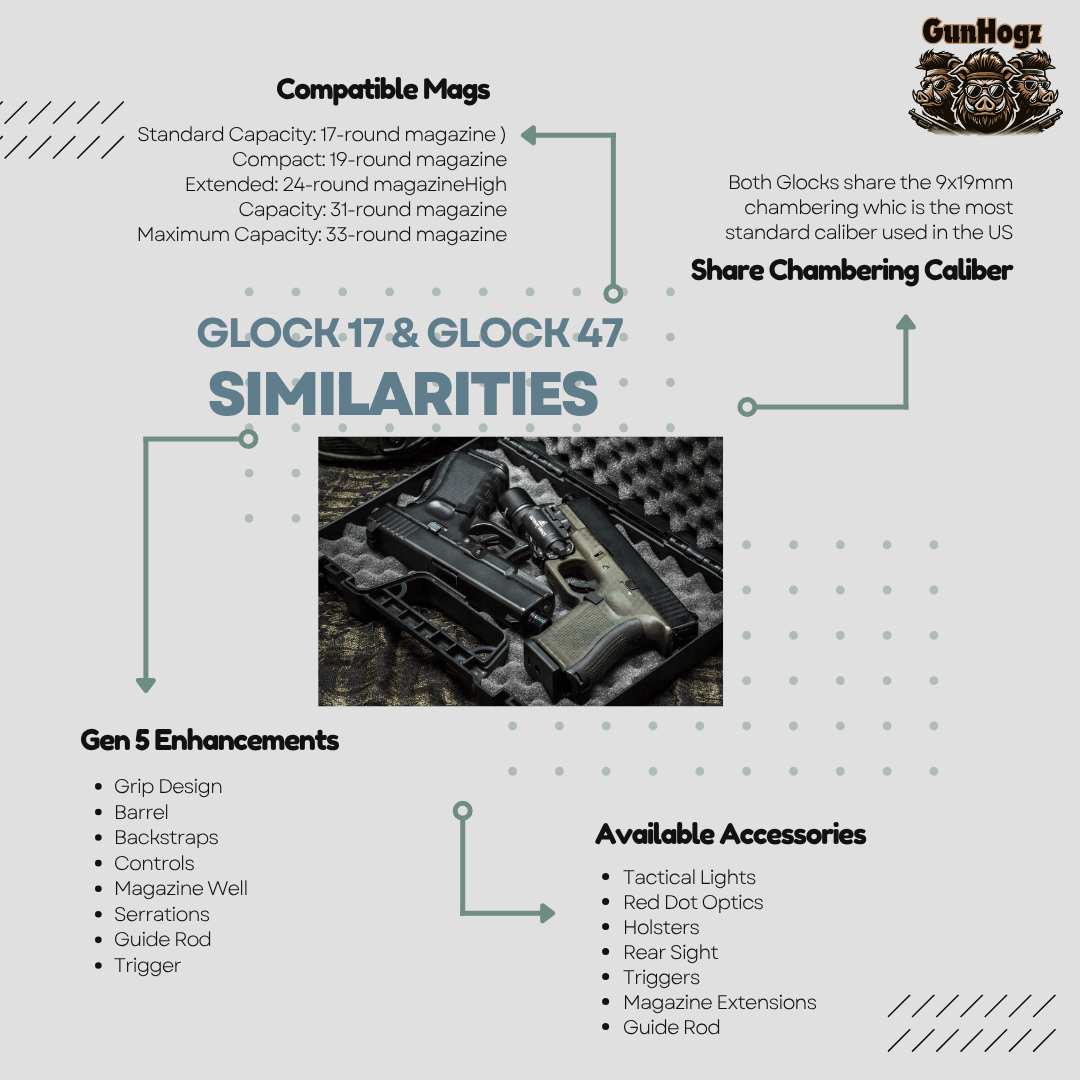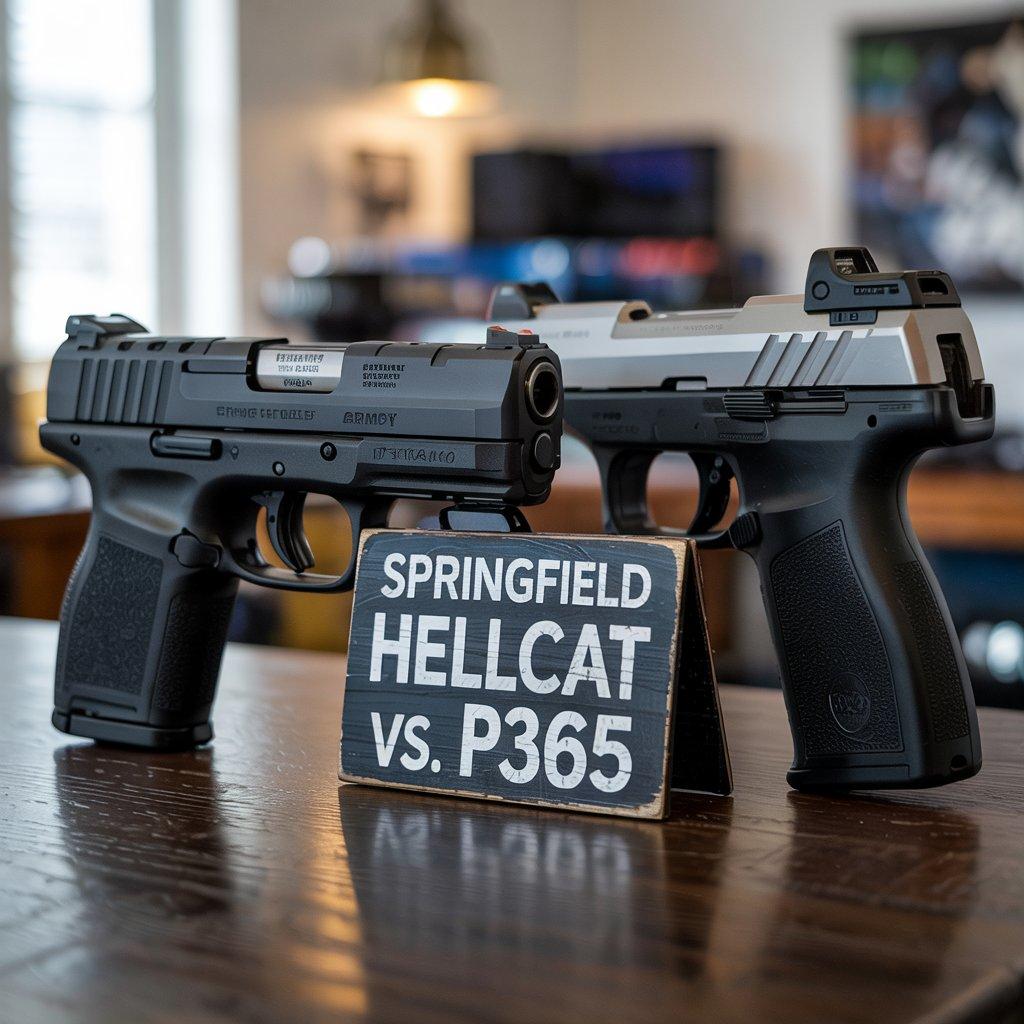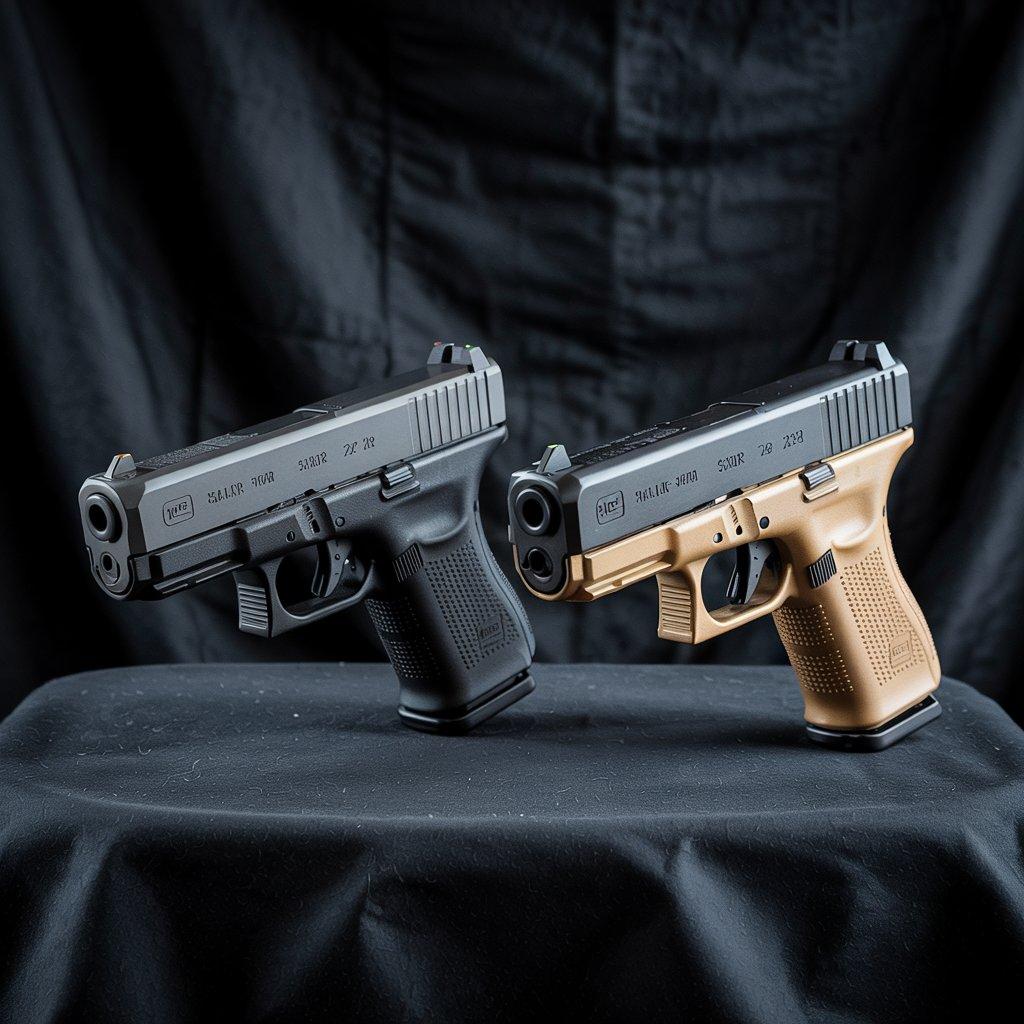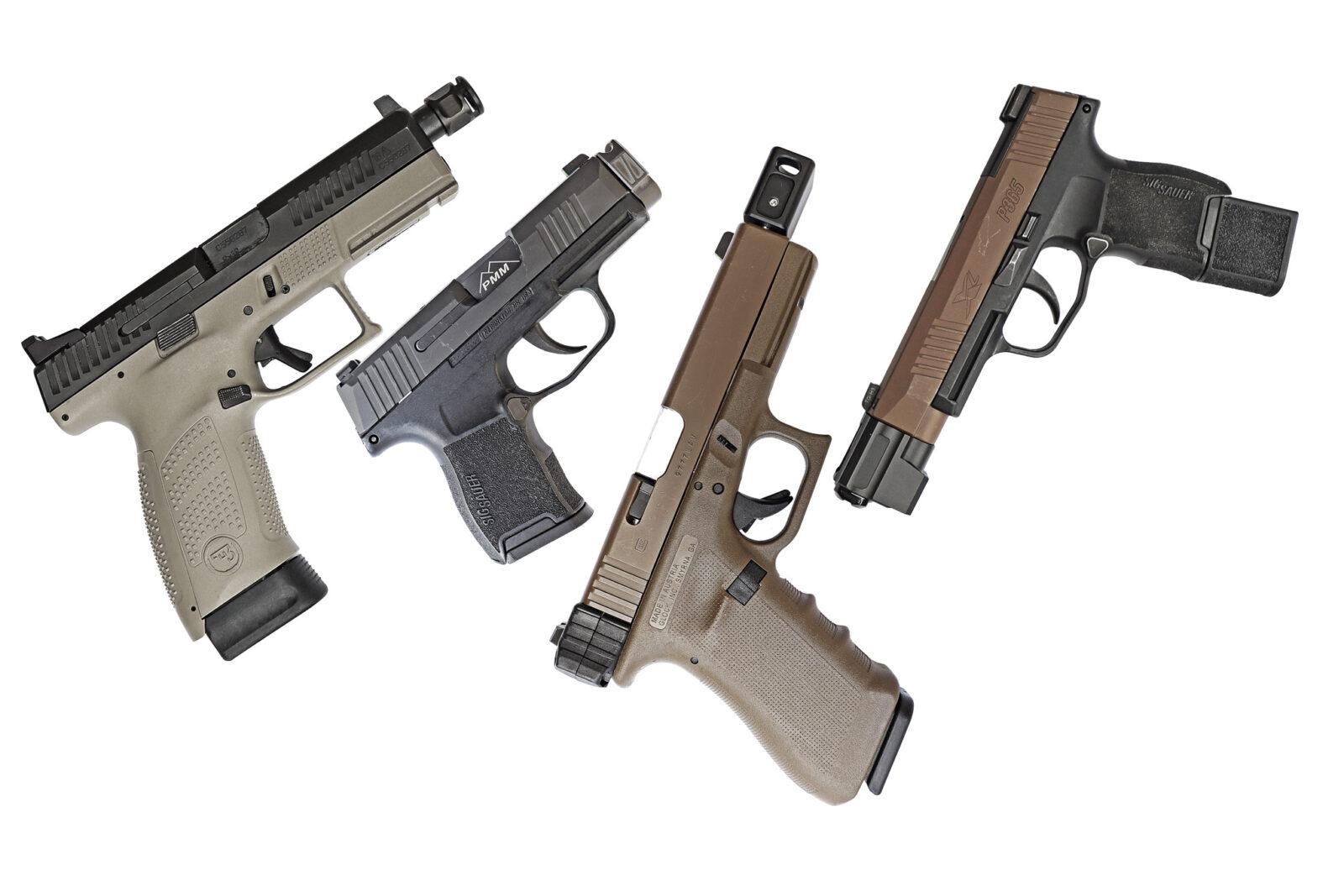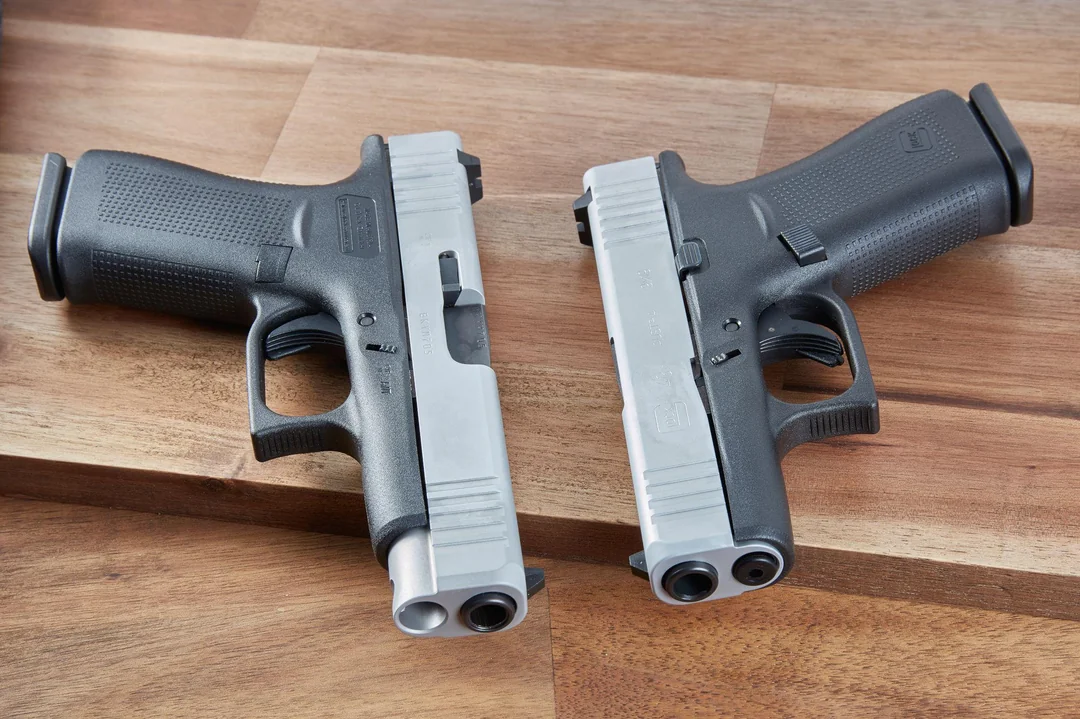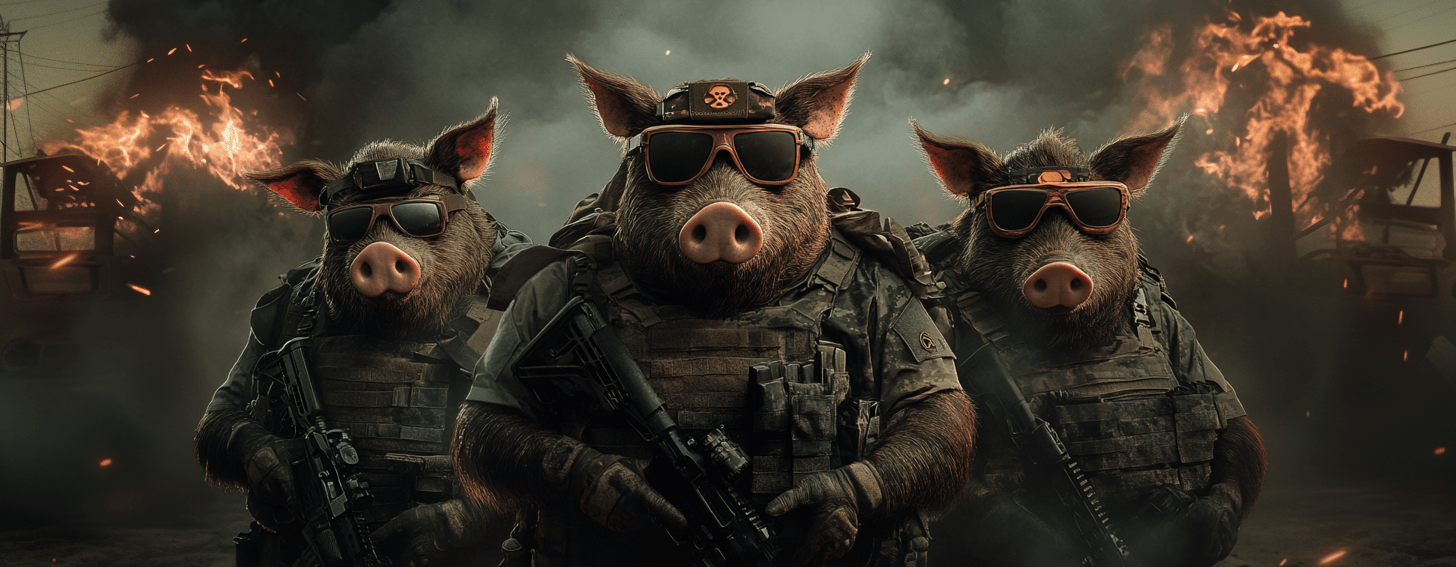The Glock 17 and Glock 47 are two of Glock’s most popular full-sized semi-automatic pistols. Both firearms work admirably for home self-defense, concealed carry, or law enforcement duty use.
These 9mm glock models share many similarities and appear almost identical at first glance. However, they have key differences that the savvy buyer should understand before making a purchase decision.
Either glock pistol will likely serve you well, but understanding the differences will help you choose the firearm that best serves your specific needs. Let’s begin with a close look at each pistol, then compare and contrast the Glock 47 vs. Glock 17.
Glock 17
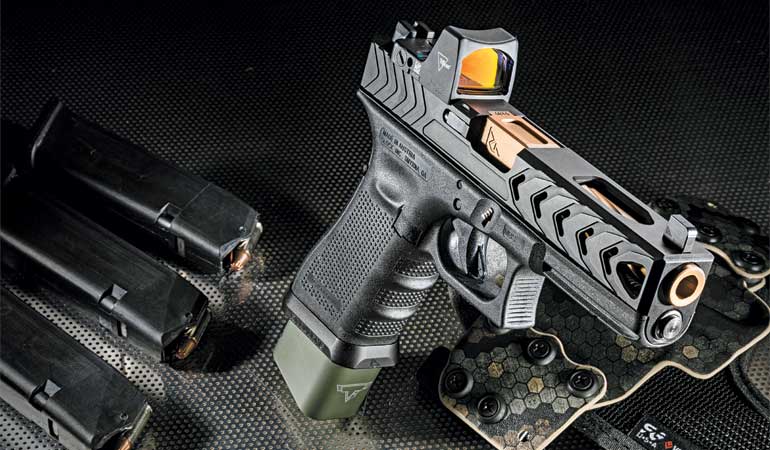
The Glock 17 has been the flagship glock pistol for over four decades. Introduced in 1982, Gaston Glock’s 17th design was adopted by the Austrian military and later became an instant hit with law enforcement and civilians in the United States.
Initially shunned because of their radically different polymer frame design, these semi-automatic pistols quickly proved their worth through superior performance and durability. Within just a few years, Glock dominated the U.S. sidearm market and became the standard by which all other pistols are judged.
Today, you’re just as likely to see a Glock 17 in police department holsters as all other pistols combined. The Glock 17 was the first glock pistol the author bought, and served as his duty pistol while overseas as a “government contractor.”
Semi-Automatic Pistol Specifications
The Glock 17 is a full-sized service pistol featuring a 4.49-inch barrel length and a full-size frame that accommodates a standard 17-round magazine. Despite its overall length and size, this firearm weighs just 25 ounces loaded—less than many steel-framed predecessors’ unloaded weights.
Most importantly, the Glock 17 cemented Glock’s reputation for exceptional durability and reliability. The pistol demonstrated remarkable high performance consistency regardless of operating conditions, with a proven trigger mechanism that functions reliably in all environments.
Legacy and Evolution
With its light weight, high magazine capacity, and enviable reliability, the Glock 17 paved the way for numerous other glock models. The Glock 19, featuring a compact frame design, is worth mentioning here as well.
With about half an inch removed from both the grip frame and the barrel/slide assembly, the Glock 19 became another instant hit. Citizens interested in concealed carry, plainclothes law enforcement officers, and even militaries flocked to this compact glock pistol, which was a direct spinoff of the infinitely popular Glock 17.
Glock 47

The Glock 47 was designed at the request of U.S. Customs and Border Protection (CBP) and introduced in 2019. While initially restricted to law enforcement agencies, it became available to civilian buyers in 2023.
At first glance, the Glock 47 appears nearly identical to the Glock 17. It features the same 4.49-inch barrel length and full-size frame that accepts standard 17-round magazines.
However, the Glock 47 offers one major advantage: enhanced modularity through superior parts compatibility. The frame features a shorter dust cover and uses a Glock 19 recoil spring, enabling slide compatibility with compact frame components.
Parts Compatibility & Modularity
This modularity requires purchasing additional components or a second glock pistol (like a Glock 19). However, the parts compatibility creates multiple configuration options for the discerning shooter.
Glock 47 + Glock 19 Configuration Options
| Configuration | Frame | Slide | Best For |
| Full Duty | G47 (full) | G47 (full) | Open carry, duty use |
| Compact | G19 (compact) | G19 (compact) | Concealed carry |
| Crossover | G47 (full) | G19 (compact) | Versatile carry |
| Extended | G19 (compact) | G47 (full) | Competition, accuracy |
This versatility allows users to customize their firearm to specific mission requirements while maintaining familiar controls, accessories, and glock magazines across all configurations.
Glock 17 vs Glock 47: Specifications Comparison
| Specification | Glock 17 | Glock 47 |
|---|---|---|
| Barrel Length | 4.49 inches | 4.49 inches |
| Overall Length | 8.03 inches | 8.03 inches |
| Weight (loaded) | 32.1 oz | 33 oz |
| Magazine Capacity | 17 rounds | 17 rounds |
| Frame Size | Full-size | Full-size |
| Dust Cover | Standard | Shorter |
| Recoil Spring | Glock 17 | Glock 19 |
| Modularity | Limited | High |
| Available Generations | Gen 3, 4, 5 | Gen 5 MOS only |
Glock 17 vs Glock 47: Similarities
Both the Glock 17 and Glock 47 share numerous similarities that make them excellent choices for law enforcement and civilian use. We’ve already discussed their identical external dimensions and nearly identical weight specifications, with the G47 being slightly heavier by just over an ounce.
Chambering and Ammunition
Both glock models share the 9×19 chambering, which serves as the de facto standard caliber for law enforcement agencies across the United States. This cartridge selection offers the most affordable and widely available ammunition options, with ongoing development of defensive and duty ammunition focused on 9mm performance.
Magazine Capacity and Compatibility
Both semi-automatic pistols utilize the same standard magazine capacity of 17 rounds. Additionally, both firearms can accommodate a wide range of glock magazines for different applications.
Compatible Glock Magazine Options
- Standard Capacity: 17-round magazine (included)
- Compact: 19-round magazine
- Extended: 24-round magazine
- High Capacity: 31-round magazine
- Maximum Capacity: 33-round magazine
- Base Pad: Compatible with extended base pad systems
The consistent magazine compatibility extends to base pad configurations and ensures seamless transitions between different capacity options depending on mission requirements.
Accessory Compatibility
Both pistols offer extensive compatibility with aftermarket accessories and tactical equipment.
Accessory Options
- Tactical Lights: Standard Glock rail system accommodates weapon-mounted lights
- Red Dot Optics: MOS system compatibility (G47 standard, G17 LEO only)
- Holsters: 100% cross-compatibility between models saves equipment costs
- Rear Sight: Aftermarket sight systems readily available
- Triggers: Compatible with aftermarket trigger mechanism upgrades
- Magazine Extensions: All Glock magazine accessories compatible
- Guide Rod: Upgraded guide rod systems available for both models
Though the Glock 47 hasn’t been around nearly as long as the previous generation Glock 17, there’s no reason to believe it won’t share the same exceptional reliability and durability with its older sibling.
Gen 5 Features
Both the Glock 17 and Glock 47 are available with Gen 5 features, representing the latest improvements to glock pistols.
Gen 5 Enhancements (Both Models)
- Grip Design: Non-finger grooves pattern for improved comfort and control
- Barrel: Precision marksman barrel for enhanced accuracy and performance
- Backstraps: Interchangeable backstraps for customized fit
- Controls: Ambidextrous slide latch and reversible magazine release for left-handed shooters
- Magazine Well: Flared design for faster, more reliable reloads
- Serrations: Forward cocking serrations on slide for improved manipulation
- Guide Rod: Enhanced dual recoil spring system for smoother operation
- Trigger: Improved trigger mechanism for consistent performance and reliability
Unfortunately, both firearms come equipped with standard polymer rear sight systems from the factory. These basic sights are functional but many users upgrade to enhanced sight systems or red dot optics for improved accuracy.
Glock 47 vs Glock 17: Key Differences
One of the biggest differences between the venerable Glock 17 and the latest Glock 47 lies in the various generations and configurations available for the G17.
Generation Options
While Gen 5 improvements are widely praised as the latest evolution of an already excellent glock pistol, some users prefer legacy models from previous generations. Gen 3 glock models probably represent the flagship of this phenomenon, with many shooters preferring the Gen 3 look, feel, and finger grooves design.
Some enthusiasts claim Gen 3 models offered the most reliable performance, and these previous generation pistols enjoy extensive aftermarket accessories support. Several Glock 17 variants remain available but are marked as “Law Enforcement Only” in line with ATF firearm classifications and through Glock’s website, including Gen 4, Gen 4 MOS, and Gen 5 MOS configurations.
Modular Optic System Availability
Meanwhile, the Glock 47 comes in only one configuration: Gen 5 MOS (Modular Optic System). However, this represents the most advanced option that the vast majority of glock pistol owners prefer, featuring the latest improvements and factory red dot compatibility.
For non-law enforcement users, the Glock 47 is the only Glock 17-sized, 9mm semi-automatic pistol available with factory machining for pistol-mounted optics. With the proliferation and increasing popularity of red dot sights, this modular optic system represents a significant market differentiator.
Enhanced Modularity Focus
The emphasis on modularity reflects current trends in both law enforcement and civilian markets. Today’s service pistols and concealed carry firearms increasingly offer modular designs that allow quick modifications between different form factors.
While this modularity requires purchasing additional parts like slide assemblies and barrels, this approach mirrors other families of modular semi-automatic pistols gaining popularity across the United States.
Law Enforcement Applications
Both glock models excel in police department applications, offering the reliability and performance that law enforcement agencies demand.
Key Law Enforcement Benefits
- Police Departments: Proven reliability and durability in demanding duty use
- Training: Consistent controls and trigger mechanism across officer equipment
- Maintenance: Simplified parts inventory and servicing reduces department costs
- Versatility: Adaptable to different roles and assignments within the agency
- Cost Efficiency: Magazine and holster compatibility reduces equipment expenses
- Performance: Reliable operation in high-stress situations and varied conditions
- Modularity: G47’s enhanced modularity particularly appeals to agencies requiring versatility
The Glock 47’s enhanced modularity particularly appeals to agencies requiring versatility in their issued firearms, allowing officers to configure their duty weapon for different roles and assignments while maintaining familiarity with controls and trigger mechanism.
So…Which Is Right for YOU?
The choice between the Glock 17 and Glock 47 comes down to several key factors that potential buyers should carefully consider.
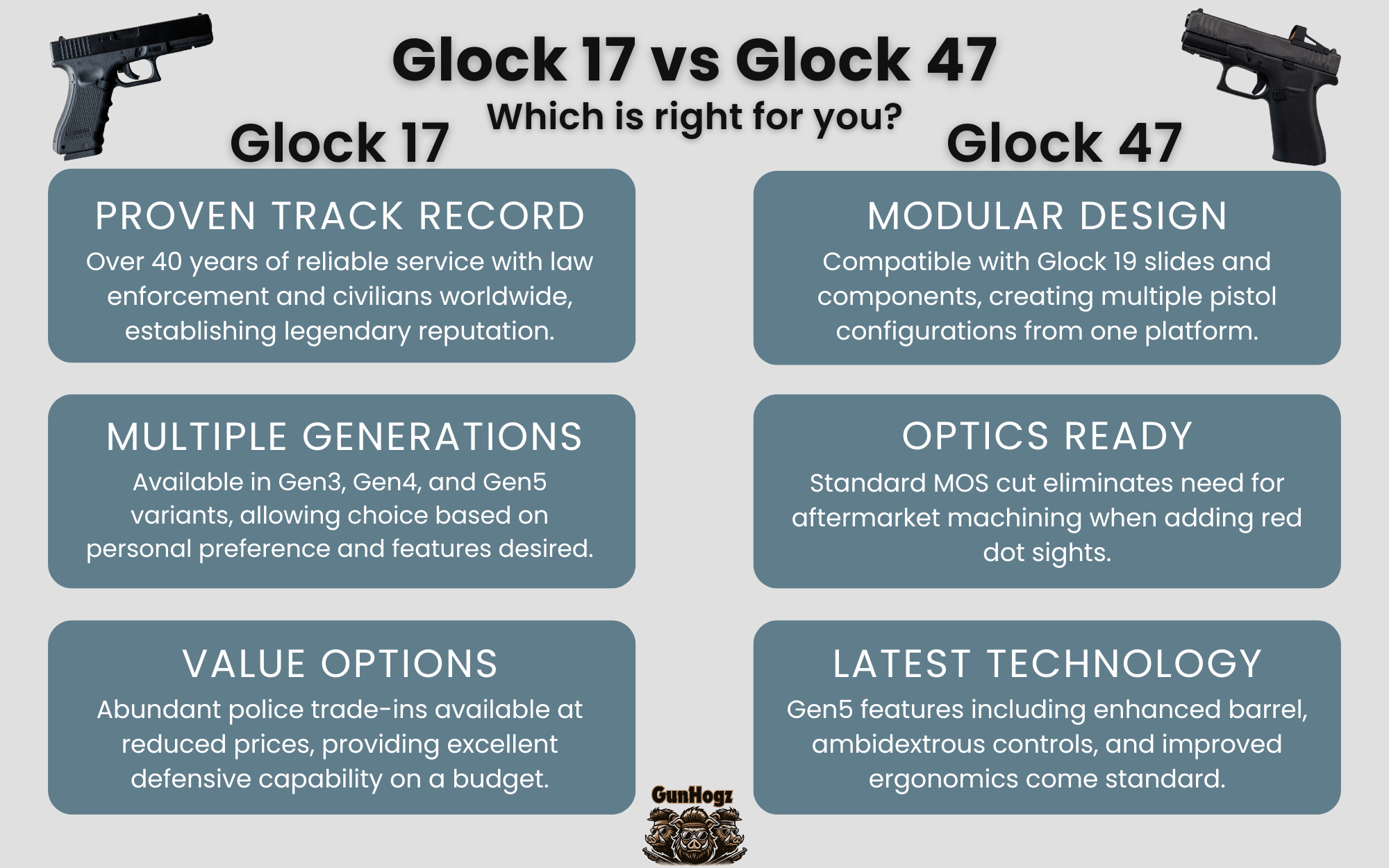
Generation Preferences
If you absolutely demand an older generation pistol, such as Gen 3 or Gen 4 models, the Glock 17 remains your primary option. However, this likely represents a small minority of current buyers in the market.
Modern Features and Future-Proofing
For most shooters, the Glock 47 emerges as the preferred choice. It incorporates the latest Gen 5 features and comes standard with the modular optic system (MOS) for red dot compatibility.
Even if you’re currently avoiding pistol-mounted optics, selecting a firearm with factory MOS cuts provides excellent future-proofing as your needs evolve and offers better resale value in the secondary market.
Modularity Advantages
The biggest advantage favoring the Glock 47 is its superior modularity and parts compatibility. If you already own a Glock 19, purchasing the Glock 47 transforms your two pistols into four distinct configurations, offering incredible versatility for different applications.
You can tailor the firearm to fit specific missions while maintaining legendary glock reliability, consistent holster compatibility, magazine interchangeability, and familiar operation—but with significantly more flexibility than any standard Glock 17 configuration offers.
Market Trends
The Glock 47 appears to represent the future direction for full-size glock pistols. This trend aligns with the widespread law enforcement transition to modular platforms like the Glock 45 currently underway across police departments nationwide.
Budget Considerations
On the other hand, numerous police trade-in Glock 17 pistols remain available in the secondary market, many available through platforms like Gunhogz.com. These options provide tremendous value, offering an excellent firearm at significantly reduced prices compared to new purchases.
A tight budget shouldn’t prevent anyone from owning a proper defensive firearm. Both the Glock 47 and Glock 17 offer exceptional reliability, durability, and performance that will serve users well in any defensive application.
Decision Matrix
| Factor | Choose Glock 17 | Choose Glock 47 |
| Budget | ✅ Police trade-ins available | Higher initial cost |
| Generation Preference | ✅ Gen 3/4 options available | Gen 5 MOS only |
| Modularity | Limited slide compatibility | ✅ Full modularity |
| Optics Ready | LEO-only MOS versions | ✅ Civilian MOS standard |
| Future-Proofing | Established platform | ✅ Latest technology |
| Parts Availability | ✅ Decades of support | ✅ Cross-compatible |
Conclusion
The bottom line is that it’s difficult to make a wrong choice with any glock pistol, regardless of specific model selection. You will be well served and strongly defended with either the innovative Glock 47 or the time-tested Glock 17.
Both semi-automatic pistols offer the reliability, accuracy, and performance that have made glock models the standard for law enforcement agencies and civilian shooters across the United States. Whether you prioritize modularity and modern features or prefer proven legacy designs, both options deliver the high performance and durability that Glock pistols are renowned for worldwide.

